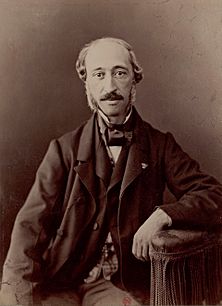Edmond Becquerel facts for kids
Quick facts for kids
Edmond Becquerel
|
|
|---|---|
 |
|
| Born | 24 March 1820 |
| Died | 11 May 1891 (aged 71) |
| Known for | First observed the photovoltaic effect Overhead projector Phosphoroscope Thermionic emission |
| Children | Henri Becquerel |
| Parent(s) | Antoine César Becquerel |
| Scientific career | |
| Fields | Physics |
Edmond Becquerel (born March 24, 1820 – died May 11, 1891) was a French physicist. He studied many interesting things like sunlight, magnets, electricity, and how light works.
He is famous for discovering the photovoltaic effect in 1839. This is the science behind how solar cells turn sunlight into electricity! He also did important work on how some materials glow in the dark, which is called luminescence and phosphorescence. Edmond was part of a very scientific family. His father, Antoine César Becquerel, was also a scientist. And his son, Henri Becquerel, later helped discover radioactivity.
Contents
About Edmond Becquerel
Edmond Becquerel was born in Paris, France. He followed in his father's footsteps, first as his student, then as his helper, and finally took over his father's job at the National Museum of Natural History.
He also became a professor at a special farming school in Versailles in 1849. Later, in 1853, he became a physics professor at the Conservatoire des Arts et Métiers. He worked closely with his father on many scientific projects.
How Solar Cells Began
In 1839, when Edmond was just 19, he made a big discovery in his father's lab. He created the world's very first photovoltaic cell. This is like a tiny, early version of a solar panel!
He used silver chloride or silver bromide to cover special metal pieces called electrodes. When he shined light on these electrodes, they made electricity. This amazing discovery is why the photovoltaic effect is sometimes called the "Becquerel effect."
Photography Fun
Edmond Becquerel was also one of the first people to experiment with photography. In 1840, he found something cool about photographic materials. These materials usually couldn't "see" red or yellow light. But he discovered that if you first shined blue, violet, or ultraviolet light on them, they would then become sensitive to red and yellow light.
This meant that early photos, like daguerreotypes, could be developed using strong red or yellow light instead of harsh chemicals. In 1848, he even made color photographs of the sun's spectrum and other images. These early color photos were hard to keep, though. Their colors would fade if they weren't kept in total darkness.
Other Cool Discoveries
Becquerel loved studying light. He looked into how light causes chemical changes. He also studied the light from the sun and electric arcs. He was very interested in how some things glow in the dark, especially certain minerals and uranium compounds.
To study this, he invented a tool called the phosphoroscope. This device let him control and measure the time between when a material was lit up and when it started to glow.
He also studied how different materials react to magnets. He was very interested in how electricity can break down chemicals. He found a lot of evidence that supported Faraday's law of electrolysis, which explains how electricity causes chemical changes. In 1853, Becquerel also discovered something called thermionic emission. This is about how heat can make electrons jump off a surface.
Awards and Recognition
Edmond Becquerel was recognized for his important work. He became a member of the Royal Swedish Academy of Sciences in 1886.
Today, there's even a special award named after him! The Becquerel Prize is given every year to someone who has done outstanding work in the field of photovoltaics, which is the science of turning sunlight into electricity.
See also
 In Spanish: Alexandre-Edmond Becquerel para niños
In Spanish: Alexandre-Edmond Becquerel para niños
- Phosphoroscope

